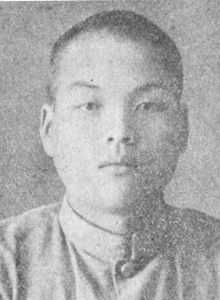Tsuyama massacre

The Tsuyama massacre (津山事件 Tsuyama jiken) was a spree killing that occurred on 21 May 1938 in the rural village of Kaio close to Tsuyama city in Okayama, Japan.
Mutsuo Toi (都井 睦雄 Toi Mutsuo), a 21-year-old man, killed 30 people,[1] including his grandmother, with a Browning shotgun, Japanese sword, and axe, and seriously injured three others before killing himself with the shotgun. Until the 1982 killing by Woo Bum-kon, this incident was regarded as the second-worst massacre by an individual in modern history, behind the 1927 killing of 45 people by Andrew Kehoe.[2]
Massacre
Mutsuo Toi cut the electricity line to the village of Kaio on the evening of 20 May, which left the community in darkness. At around 1:30 am on 21 May, he killed his 76-year-old grandmother by decapitating her with an axe.[2] Then he strapped two flashlights to his head and prowled through the village entering the homes of his neighbours. He killed 29 neighbours (27 of whom died at the scene of the incident, while two others were fatally wounded, dying of their injuries later)[3] and seriously injured three others in about an hour and half using a Browning shotgun, a Japanese sword and an axe. This was almost half of the residents of the small community.[2] At dawn he committed suicide by shooting himself in the chest.[4]
Mutsuo Toi
Mutsuo Toi (都井 睦雄 Toi Mutsuo, March 5, 1917 – May 21, 1938) was born in Okayama Prefecture to well-off parents. His parents died of tuberculosis when he was a baby, so he and his sister were brought up by their grandmother. He was originally outgoing, but at the age of 17 he became socially withdrawn after his sister married in 1934.
He was interested in the story of Sada Abe, the prostitute who, in May 1936, strangled her lover then severed his penis. He had started writing a novel, Yūtokaiōmaru (雄図海王丸).
He took part in "Yobai" (夜這い) or "night-crawling", a rural custom which involved creeping into young women's bedrooms during the night to seek sexual intercourse.[3]
From his suicide notes it appears that after May 1937 when he was diagnosed as suffering from tuberculosis, the young women in the village rejected his sexual advances.
Suicide notes
Toi left several long notes which revealed that he was concerned about the social impact of his tuberculosis, which in the 1930s was an incurable fatal illness. He felt that his female neighbours became cold towards him once they knew of his illness, and that he was despised as hypersexual.
For revenge, he decided to enter their homes and kill them. He waited for the time when the women returned to their houses. The authorities were concerned, and his gun license was revoked. He however prepared swords and guns secretly.
He regretted that he would not be able to shoot some people he wanted to, as that would have involved killing people he regarded as innocent. He also wrote that he killed his grandmother because he could not bear leaving her alive to face the shame and social stigma that would be associated with a "murderer's grandmother".
See also
References
Notes
- ↑ 理不尽な凶行、遺族ら「無念」…秋葉原無差別殺傷事件 (in Japanese). Sports Hochi. 2008-06-09. Retrieved 2008-06-13.
- ↑ 2.0 2.1 2.2 ForeignPolicy.Com The List: The World’s Worst Shooting Rampages Kaio, Japan Date: May 21, 1938 Casualties: 29 killed; three wounded What happened: Mutsuo Toi, a 21-year-old from a wealthy family, had been shunned by women and rejected from military service for having tuberculosis. Finally one night, he snapped. He cut the electricity to his village, bound two flashlights to his head, and shot or stabbed nearly half of the small community over the course of 90 minutes before then shooting himself at dawn. Before embarking on his rampage, he decapitated his grandmother with an ax. Weapons of choice: Browning shotgun purchased legally, ax, samurai sword Aftermath: Toi left notes complaining of being ostracized for his disease. His bizarre attack has inspired at least four books, several films, and at least one play. Until 1982, his rampage was known as the world’s worst massacre by a single individual.
- ↑ 3.0 3.1 津山事件 (in Japanese). 無限回廊. Retrieved 2008-06-13.
- ↑ "LUNATIC KILLS 27 IN JAPAN; Young Man Shoots Sleeping Men, Women and Children". The New York Time. May 22, 1938. Retrieved 22 April 2009.(subscription required)
Bibliography
- Serial and Mass Murder: Theory, Research and Policy, Thomas O'Reilly- Fleming (Editor), Canadian Scholars Press (1995), ISBN 1-55130-066-4
- Tsukuba, Akira. 津山三十人殺し―日本犯罪史上空前の惨劇, Tōkyō: Shinchōsha, 2005 ISBN 978-4-10-121841-0
External links
- (Japanese) Tsuyama 30 people murders